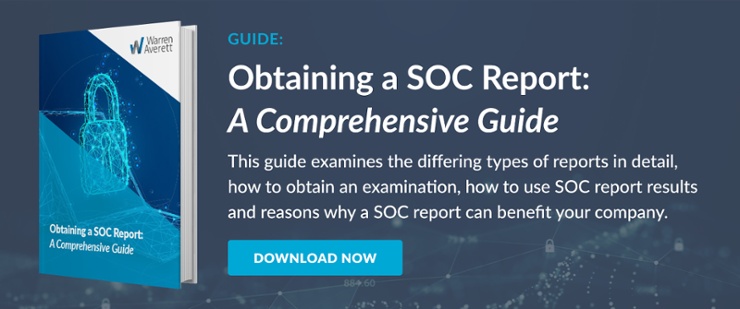SOC 1 vs SOC 2 (Which Does My Company Need, and Why?)

System and Organization Controls (SOC) reporting is key for businesses that provide services to others as vendors because it establishes trust with your customers concerning your organization’s internal controls and processes.
There are several different kinds of SOC reports, with SOC 1® and SOC 2® being the most common.
SOC 1: addresses the internal controls a company has regarding financial reporting.
SOC 2: focuses on non-financial controls in critical trust services categories.
The differences between these two reports inform service organizations about which they might need. When considering SOC 1 vs SOC 2, you might be wondering: Which is appropriate for your organization? What’s the difference in how the reports are used? Are there different areas of emphasis?
Here, we’ll explore SOC 1 vs SOC 2 in several head-to-head comparisons to help your business know which one is right for you.

SOC 1 vs SOC 2: Types of Organizations
Your organization’s type and the kinds of services that you offer are key determinants of the SOC report needed for your business.

A SOC 1 report, focused on financial reporting controls, is commonly performed for service organizations such as trust departments, registered investment advisors, employee benefit or retirement plan operators, payroll processing firms, loan servicers and other similar organizations.
A SOC 2 report, on the other hand, is focused on non-financial controls around elements such as, but not limited to, security, data and access.
Typically, a SOC 2 is performed on data center co-locations, Software as a Service (SaaS) providers, cloud service providers, managed IT services and so on. Of course, SOC 2 reports aren’t restricted to only these types of businesses, and the list grows as companies increase the data they process and their digital footprint.
SOC 1 vs SOC 2: Report Use and Access
SOC reports inherently contain a lot of information about a business. As a result, you may have concerns about the use of these reports and who accesses them. Again, the very nature of a SOC 1 vs SOC 2 report signals how it’s used, but it also points to who views and uses it.

A SOC 1 report is restricted to the service organization’s management, the user entity (likely the client or customer who has requested your SOC report) and the user auditors (internal or financial auditor for the user entity).
A SOC 2 report’s users are broader, but still restricted, and include the service organization itself, user entities of the system, business partners, prospective user entities and business partners and regulators who have an understanding of the service organization and its controls.
SOC 1 vs SOC 2: Areas of Emphasis and Intent
Each type of report has a specific purpose and a different area of focus.

As we’ve already noted, the SOC 1 report focuses on financial controls. It’s intended to report on the controls at a service organization that pertain to the organization’s financial reporting and offers information relevant to the effect the service organization controls have on the user entity’s financial reporting.
With SOC 2, the focus is non-financial controls. The report is intended to meet the needs of a broad range of users for understanding the internal controls of a service organization across the five trust services categories:
- security (also known as the Common Criteria),
- availability,
- processing integrity,
- confidentiality, and
- privacy
The report is based on the TSP 100 2017 Trust Services Criteria specified by the AICPA.
SOC 1 vs SOC 2: Why Would You Need One?
Some service organizations may only need a SOC 1. Others may need a SOC 2. And still others may need both.

Organizations needing a SOC 1 report find them useful in evaluating their internal controls, and they are also utilized when user entity auditors plan and perform financial statement audits.
In the case of SOC 2, while the report can be helpful for internal improvement and evaluation of the non-financial controls that it’s focused on, the need is usually driven by customers.
Many user entities are becoming proactive about security and controls and are taking a closer look at the companies they do business with. Even if you haven’t yet been asked for a SOC 2 report, it’s likely that you will be in the future, and it can be a powerful business differentiator.
Learn more about SOC Reports
SOC reporting is crucial for modern businesses, both for those providing services and those managing vendors, and knowing the difference in SOC 1 vs SOC 2 can be very helpful for organizations. Yet, the landscape of SOC reporting—who needs it, which report is needed, what are the differences and so on—can make navigating SOC reporting confusing.
This article was originally published on April 26, 2021.

